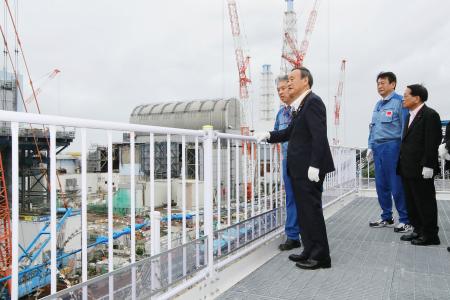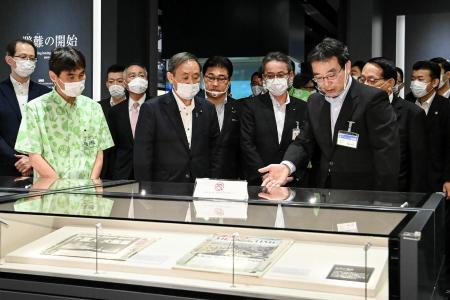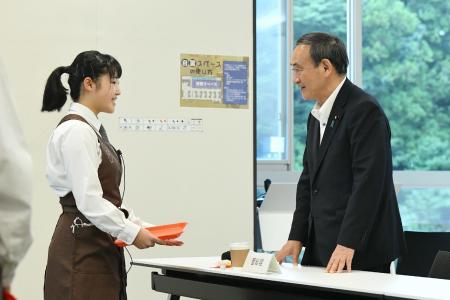





OKUMA/FUTABA (Fukushima Pref.)
Japanese Prime Minister SUGA Yoshihide on Saturday visited Fukushima Prefecture, which was hit hard by the March 2011 earthquake and tsunami, and affected by the subsequent nuclear accident, for the first time since he took office on Sept. 16.
Suga chose Fukushima as the destination of his first domestic local trip as prime minister apparently in a bid to emphasize his cabinet’s stance of attaching importance to the reconstruction of areas affected by the natural and nuclear disasters, just as the cabinet led by his predecessor, Shinzo Abe, did.
During the one-day trip, Suga visited Tokyo Electric Power Company Holdings Inc.’s Fukushima No. 1 nuclear plant, which was knocked out by the quake and tsunami. While inspecting the damaged No. 1 to No. 4 reactors at the plant from a higher ground, he received explanations from TEPCO employees about the work to decommission the plant and treat contaminated water from the power station, which straddles the towns of Okuma and Futaba.
“It is a tough work, but I hope it will be done steadily,” Suga said, showing the government’s readiness to continue offering full-fledged support for the work.
After the inspection, Suga told reporters: “Without the reconstruction of Fukushima, there will be no recovery of Tohoku. Without the reconstruction of Tohoku, there will be no revival of Japan. This is a basic policy of my cabinet.”
Fukushima is part of Tohoku, the country’s northeastern region, and one of the three Tohoku prefectures particularly hit hard by the quake and tsunami.
Later, Suga visited a museum built by the Fukushima prefectural government to pass on the lessons from the natural and nuclear disasters to future generations. The Great East Japan Earthquake and Nuclear Disaster Memorial Museum, located in Futaba, opened about a week ago.
Suga also visited a local public junior and senior high school and held talks with some of its students.
The Suga cabinet’s basic policy, adopted recently, does not refer to restoration related to the 2011 disasters, and the opposition side has slammed this as showing that the Suga cabinet is backing down on the issue of postdisaster reconstruction.
But Suga rebutted the criticism, telling reporters on Saturday that post-disaster reconstruction is clearly stated in written instructions he handed to all ministers on the day when his cabinet was formed.
On how to dispose of treated water kept in storage tanks at the Fukushima nuclear plant, Suga said that his government will decide a policy on the matter with its responsibility, apparently aiming to dispel concerns that he is not very enthusiastic about disaster-hit areas.
JIJI Press